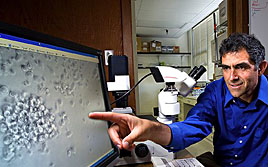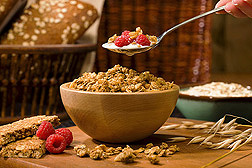| April 2010 |
Foodborne Staph Toxin Pinpointed by New AssayAgricultural Research Service (ARS) scientists have developed a superior new test for finding staphylococcal enterotoxin A, or "SEA." Produced by Staphylococcus aureus bacteria, this toxin is a leading cause of foodborne illness in the United States and worldwide. The new test can detect the toxin at levels that are a remarkable one billion times lower than the current "gold standard" assay for SEA. Experiments with chicken, beef and milk indicate that the assay reliably distinguishes active from inactive toxin and yields reproducible results. Scientific contact: Reuven Rasooly, (510) 559-6478, ARS Foodborne Contaminants Research Unit, Western Regional Research Center, Albany, Calif. |
|
|
|
New Vaccines for Calves May Help Thwart E. coli O157:H7Immunizing calves with either of two forms of a vaccine newly developed by Agricultural Research Service (ARS) scientists might reduce the spread of sometimes deadly Escherichia coli O157:H7 bacteria. The microbe can flourish in the animals' digestive tracts, yet doesn't cause them to show clinical symptoms of illness. In humans, however, E. coli can cause bouts of diarrhea and, sometimes, life-threatening hemolytic uremic syndrome. One form of the vaccine is comprised of cells of a strain of E. coli O157:H7 that is lacking a gene known as hha. A second form of the vaccine contains an E. coli strain lacking both hha and a second gene, sepB. In either vaccine, the E. coli strain produces a large quantity of what are known as immunogenic proteins. These proteins trigger the immune system response that prevents E. coli O157:H7 from successfully colonizing cattle intestines. Scientific contact: Vijay Sharma, (515) 337-7279, ARS Food Safety and Enteric Pathogens Research Unit, Ames, Iowa. |
Egg Processing Plant Carts Can Harbor BacteriaPlywood-shelved carts that are used to transport eggs into processing plants can harbor Enterobacteriaceae, according to a microbial survey conducted by Agricultural Research Service (ARS) scientists on three visits to two processing plants in the southeastern United States. Enterobacteriaceae, a bacterial family that includes the human pathogens Salmonella and Shigella, are known to contaminate the shell egg processing environment. The researchers found 100 percent prevalence for Enterobacteriaceae on carts at one plant and 80 percent at the other. Knowing which bacteria are present and their location are vital pieces of information in developing strategies to reduce and remove bacterial contamination. The findings of this survey will be used by microbiologists working with the shell egg industry and regulators to encourage development of better sanitation procedures or the use of shelving materials that are easier to clean. Scientific contact: Michael Musgrove, (706) 546-3340, ARS Egg Safety and Quality Research Unit, Richard B. Russell Research Center, Athens, Ga. |
|
|
|
Kids Lose Pounds, Gain Fitness, in Houston StudyInnovative, kid-friendly strategies for losing weight and gaining nutrition savvy—plus physical fitness skills—are emerging from scientific studies funded by the Agricultural Research Service (ARS). Fifty-seven Hispanic children who were either overweight or at risk of becoming so were assigned to either a self- and parent-taught program or an intensive, instructor-led regimen. When evaluated at the end of the 6-month study, kids in the instructor-led course had significantly greater weight loss as well as greater "physical quality of life"—as measured by their answers to a standard questionnaire—than did the kids in the self-taught program. What's more, one and two years later, youngsters in the instructor-led team had significantly greater decreases in their body mass index, or BMI, than did the self-taught children. These preliminary results suggest that a school-based weight-management program might be effective in reaching large numbers of kids. Scientific contact: Craig A. Johnston, (713) 798 2068, ARS Children's Nutrition Research Center at Baylor College of Medicine, Houston, Texas. |
Cooling Inflammation for Healthier ArteriesScientists funded by the Agricultural Research Service (ARS) have reported new reasons for choosing "heart-healthy" oats at the grocery store: compounds called avenanthramides. Chronic inflammation inside the arterial wall is part of the process that eventually leads to a disorder known as atherosclerosis. Nutritionist Mohsen Meydani and colleagues have reported findings that suggest the avenanthramides of oats decrease the expression of inflammatory molecules. The study showed that forms of avenanthramides possess potential anti-inflammatory properties through inhibiting factors that are linked with activating proinflammatory cytokines. Scientific contact: Mohsen Meydani, (617) 556-3126, Vascular Biology Laboratory, Jean Mayer USDA Human Nutrition Research Center on Aging, Boston, Mass. |
|
|
|
Potential of Dairy-Based Package Wraps OutlinedFood-packaging products made from dairy ingredients could provide a viable alternative to petroleum-based packaging products, according to a chapter written by Agricultural Research Service (ARS) scientist Peggy Tomasula for a new book, "Dairy-Derived Ingredients: Food and Nutraceutical Uses." Tomasula's chapter in the new book is titled "Using Dairy Ingredients to Produce Edible Films and Biodegradable Packaging Materials." The chapter focuses on films made from dairy proteins, with an emphasis on those based on casein and whey, the major proteins found in milk. It also covers research efforts to improve the proteins' mechanical and barrier properties so that these natural materials eventually could be used in a variety of future applications. ARS scientists are in the process of developing strong, biodegradable dairy-based films that are better oxygen barriers than petrochemical-based films. Scientific contact: Peggy M. Tomasula, (215) 233-6703, ARS Dairy Processing and Products Research Unit, Eastern Regional Research Center, Wyndmoor, Penn. |
Helpful Yeast Battles Food-Contaminating AflatoxinPistachios, almonds and other popular tree nuts might someday be routinely sprayed with a yeast called Pichia anomala. Laboratory and field studies by Agricultural Research Service (ARS) plant physiologist Sui-Sheng (Sylvia) Hua have shown that the yeast competes successfully for nutrients—and space to grow—that might otherwise be used by an unwanted mold, Aspergillus flavus, which produces aflatoxins. Hua has received a patent for use of the yeast as an eco-friendly way to protect tree nuts, as well as corn, from becoming contaminated with aflatoxins. In tests conducted in a California pistachio orchard, Hua and colleagues found that spraying the trees with the yeast inhibited incidence of A. flavus in pistachios by up to 97 percent, compared to unsprayed trees. Scientific contact: Sui-Sheng (Sylvia) Hua, (510) 559-5905, ARS Plant Mycotoxin Research Unit, Western Regional Research Center, Albany, Calif. |
|
|
|
Studies Provide Insight into Key Oat ChemicalStudies conducted by Agricultural Research Service (ARS) scientists are helping to increase understanding about the environmental factors that regulate avenanthramide (Avn) production in oat grain. Avns, metabolites with potent antioxidant properties, are one reason oats have been widely touted for their many health benefits. The specific purpose of Avns inside the oat plant is still largely unknown, but previous studies have found an increased production of Avns in oat leaves when the plant is attacked by a fungus, particularly crown rust. This finding leads researchers to believe that Avns help oat plants fight off these fungi. They also found that Avn production is likely influenced by additional environmental factors, because not all cultivars with strong crown rust resistance produced high Avn concentrations. Scientific contact: Mitchell Wise, (608) 262-9242, ARS Cereal Crops Research Unit, Madison, Wis. |
Secrets to Superb Malting Barleys Explored by ARS ResearchersAgricultural Research Service (ARS) researchers are discovering more about what goes on inside barley grains as they germinate, or sprout, in the malt house. Sprouting is one of many steps that go into making malt. Findings from the scientists' basic and applied research will help plant breeders develop even better malting barleys for tomorrow. Of particular interest are the specialized enzymes that the grain creates while it is sprouting. These enzymes, for example, convert the grain's stored proteins into their component amino acids, and convert the stored carbohydrates into what are known as "simple sugars." Scientific contact: Mark Schmitt, (608) 262-4480, ARS Cereal Crops Research Unit, Madison, Wis. |
|
|
|
Inventing New Oat and Barley BreadsDelicious new all-oat or all-barley breads might result from laboratory experiments now being conducted by Agricultural Research Service (ARS) scientists. In preliminary experiments, the researchers made experimental all-oat or all-barley breads, as well as whole-wheat breads, using a commercially available, plant-derived carbohydrate known as HPMC (short for hydroxypropyl methylcellulose). They are interested in HPMC as a substitute for gluten, a compound present in wheat but lacking in other grains such as oats and barley. They determined that barley, oat, and whole-wheat breads made with HPMC had cholesterol-lowering effects. Scientific contact: Wallace Yokoyama, (510) 559-5695, ARS Processed Foods Research Unit, Western Regional Research Center, Albany, Calif. |











